Personal Protection for the Pesticide Applicator and Worker
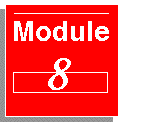
Personal Protection for the Applicator and Worker Module
Pesticides can enter the body through the skin, the eyes, the mouth, and
the lungs. The most common cause of pesticide poisoning for applicators is
through skin contact. Some pesticides enter the body through the skin quite
readily. Concentrates can be especially dangerous. Some parts of the body absorb
pesticides extremely fast and need extra protection. Two such areas are the head
and the scrotum. Most of a pesticide spilled on your skin is absorbed in the
first few minutes. If any pesticide is spilled on you, wash it off immediately.
It is best to avoid direct contact with pesticides by wearing the proper
protective clothing. The pesticide label will tell you what protective equipment
is necessary. Wear it!
 Would you like to try a study question?
Would you like to try a study question?
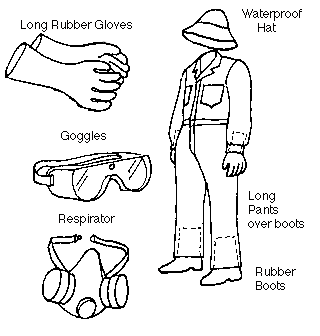
Goals of This Module
- Understand the importance of personal protective equipment worn during pesticide
application.
- Understand why there are different fabrics and materials used to protect
applicators and how they differ.
- Learn the importance of and method for layering protective clothing.
- Learn the basics of respirators and their use.
Gloves
Always wear unlined, elbow length chemical-resistant gloves when handling all
pesticides except those that are relatively nontoxic (category IV or lower
toxicity). The elbow length gloves protect your wrists and prevent pesticides
from running down your sleeves into your gloves.
 Would you like to try a study question?
Would you like to try a study question?
Glove materials include nitrile, butyl, neoprene, natural rubber (latex),
polyethylene, polyvinylchloride (PVC) and barrier laminates like 4H® and Silver
Shield®. Current research indicates that nitrile, butyl, and neoprene offer good
protection for both dry and liquid pesticides. Neoprene is not recommended for
fumigants. Natural rubber is only effective for dry formulations. Never use
leather or cotton gloves. Cotton and leather gloves can be more hazardous than
no protection at all because they absorb and hold the pesticide close to your
skin for long periods of time. Check the quality of construction and material
before buying any glove because efficacy varies with the manufacturer.
Protection increases with the thickness of the materials, but extra thick gloves
may interfere with dexterity. Never use fingerless gloves.
 Would you like to try a study question?
Would you like to try a study question?
 Would you like to try a study question?
Would you like to try a study question?
Remember that proper use is as important as selection. Check closely for holes
by filling the gloves with air or clean water and gently squeezing. Discard the
gloves if any holes appear. In the case of overhead work, turn glove cuffs up to
form a cup to trap any liquid that runs down the arm. When you are finished
spraying, wash your gloves with detergent and water before you remove
them. This way, you will not contaminate your hands or the inside of the gloves
when you remove them. Wash your hands with lots of soap and water after you
remove the gloves.
Clean and store gloves for reuse. Replace gloves periodically because most
materials will accumulate pesticide residues over time. Nitrile and neoprene
gloves can be used for 120 to 160 work hours. Replace PVC and natural rubber
gloves after 40 work hours. Slash discarded gloves so that they cannot be used
by someone else. Wrap in a plastic bag and put with an empty pesticide container
for proper disposal.
 Would you
like to try a study question?
Would you
like to try a study question?
Body Covering
Regular work attire of long pants and a long-sleeved shirt, shoes, and socks are
acceptable for slightly toxic (category III) and relatively non-toxic (category
IV) pesticides. Many applicators prefer work uniforms and cotton coveralls that
fit the regular-work-attire description and provide equal protection.
Applicators should reserve one set of clothing for pesticide use only. Launder
and store separately from all other clothing.
To apply moderately toxic (category II) or highly toxic (category I) chemicals,
wear a clean, dry protective suit that covers your entire body from wrists to
ankles. The sleeves must be long enough to overlap with gloves. Openings, such
as pockets, should be kept to a minimum. Protective suits are one- or two-piece
garments, such as coveralls. They should be worn over regular work clothes and
underwear. Protective suits may be disposable or reusable. They are available in
woven, nonwoven, coated and laminated fabrics. The degree of protection
increases as one moves from woven to nonwoven to coated and laminated fabrics.
Read the manufacturer's label for specific information related to care and
intended use. Good quality construction, proper fit, and careful maintenance or
disposal are also important.
Woven fabrics provide a barrier of fabric and air between the wearer and the
pesticide. The effectiveness of the barrier depends on the specific properties
of the fabric. Tightly woven, cotton twill offers better pesticide protection
than other woven fabrics. Cotton coveralls are a sensible choice for general use
because they are comfortable, lightweight, readily available, reusable, and
affordable. They reduce the risk of dermal exposure to pesticides in dust,
granule, or powder form. They do not protect the wearer against spills, sprays,
or mists and are not recommended for use with liquid pesticides. Cotton
coveralls may be reused if washed according to the laundry instructions in
Module 7.
 Would you like to try a study question?
Would you like to try a study question?
 Would you like to try a study question?
Would you like to try a study question?
Nonwoven fabrics have a random orientation of fibers which do not allow direct
paths through the material. Coveralls of nonwoven fabrics are less comfortable
than coveralls made of woven fabric. Precautions should be taken to avoid heat
stress situations. Most nonwoven suits are disposable; they should be discarded
after eight hours of use.
Uncoated nonwoven fabrics are convenient for use with pesticides in dust,
granule, or powder form. They do not protect the wearer against spills, sprays,
or mists and are not recommended for use with liquid pesticides. They should not
be worn when using chlorinated hydrocarbons. Tyvek, a 100% spunbonded
polyethylene fabric made by DuPont, is an example of an uncoated nonwoven
fabric.
Fabrics can be made more resistant to pesticide penetration by laminating fabric
layers and/or by applying chemical coatings. Chemical -resistant protective
suits of coated or laminated fabrics are a must if you (or your helper) will be
in a mist or spray that would wet your clothing. Coated and laminated fabrics
resist water penetration, but not all of these fabrics qualify as chemical
resistant. Chemical-resistant suits are recommended when handling highly toxic
(category I) pesticides.
 Would you like to try a study question?
Would you like to try a study question?
Coated and laminated protective suits used for pesticide protection are listed
below:
1) Tyvek QC, a DuPont product of 100% spunbonded polyethylene fabric coated with
a polyethylene film, protects the wearer against dry and liquid drift or
splashes. It does not protect against chlorinated hydrocarbons or
organophosphorus compounds. It is not chemical- resistant and is rather
uncomfortable in hot weather. It is a disposable product.
2) Tyvek QC+ is DuPont Tyvek that is laminated with Saranex-23P, a saran film
made by Dow Chemical. It provides added breakthrough protection from dry and
certain liquid pesticides at the category I and category II toxicity levels. It
does not protect against chlorinated hydrocarbons and is uncomfortable in hot
weather. It is a disposable product.
3) Waterproof rainwear. Fabrics with PVC, butyl, and neoprene coatings protect
the user against liquid and toxic pesticides. Current research indicates that
butyl and neoprene are more resistant than PVC. Wearers complain that these
protective suits are cumbersome and uncomfortable in hot weather. They are
reusable if properly maintained, but their longevity is still under
investigation.
4) Goretex, a microporous film laminate produced by W.L. Gore and Associates,
Inc., is chemically resistant and comfortable to wear. It is not yet a practical
choice because of its expense and unresolved maintenance problems.
Apron
Wear a chemical-resistant apron when repairing or cleaning spray equipment and
when mixing or loading. This is a good practice for all pesticides. It is
essential for pesticides of category I and II toxicity. Aprons offer excellent
protection against spills and splashes of liquid formulations, but they are also
useful when handling dry formulations such as wettable powders. Aprons can be
easily worn over other protective clothing and are comfortable enough for use in
warm climates. Choose an apron that extends from the neck to at least the knees.
Some aprons have attached sleeves. Nitrile, butyl, and neoprene offer the best
protection. PVC and natural rubber are also available.
Boots
Wear unlined chemical-resistant boots which cover your ankles when handling or
applying moderately or highly toxic pesticides. Purchase boots with thick soles.
Nitrile and butyl boots appear to give the best protection. Do not use leather
boots. If chemical-resistant boots are too hot to wear in warm climates or too
difficult to put on, try wearing chemical-resistant overboots with washable
shoes (such as canvas sneakers or layered socks.) Remember to put your pant legs
outside the boots, otherwise the pesticide can drain into the boot. Wash boots
after each use and dry thoroughly inside and out to remove all pesticide
residue. Use them only for pesticide applications. It is wise to keep two pair
of boots on hand in case of accidental contamination. Wash socks and canvas
sneakers worn under chemical-resistant boots, according to the laundry
instructions given in Module 7. Boots should be replaced at least yearly. As
a reminder, write the date of purchase on the boot.
 Would you like to try a study question?
Would you like to try a study question?
Goggles or Face Shield
Wear shielded safety glasses; a full-face respirator; snug-fitting, non-fogging
goggles; or a full-face shield whenever the chemical could possibly contact your
eyes. Safety glasses with brow and side shields are acceptable for low exposure
situations. Always wear goggles or full-face respirator when you are pouring or
mixing concentrates or working in a highly toxic spray or dust. In high exposure
situations when both face and eye protection are needed, a face shield can be
worn over goggles. Clean them after each use. Be careful of the headband; it is
often made of a material which readily absorbs and holds chemicals. Have several
spares and change them often or use a chemical-resistant strap. If possible,
wear the strap under your head covering.
 Would you like to try a study question?
Would you like to try a study question?
 Would you like to try a study question?
Would you like to try a study question?
Head and Neck Coverings
The hair and skin on your neck and head must be protected too. This is most
important in situations where exposure from overhead dusts or sprays is
possible, such as in airblast spraying operations or flagging.
Chemical-resistant rain hats, wide brimmed hats, and washable hard hats (with no
absorbing liner) are good. In cool weather, chemical-resistant parkas with
attached hoods are a good choice. If the attached hood is not being used, tuck
it inside the neckline so that it will not collect pesticides. Do not use cotton
or felt hats; they absorb pesticides.
 Would you like to try a study question?
Would you like to try a study question?
 Would you like to try a study question?
Would you like to try a study question?
Chemical-Resistant Materials
EPA Chemical Resistance Category Selection Chart
FIFRA requires pesticide users to follow all personal protective equipment (PPE)
instruction found on the pesticide label. These instructions are the minimum PPE
requirements. More protection may be a good idea, and one that the applicator
should always consider. Pesticide labels that list examples of PPE materials
will often also specify a chemical-resistance category for the product. The
categories are lettered A through H. Here is an example label statement:
"Some materials that are chemical-resistant to this product are listed below. If
you want more options, follow the instructions for category (F) on the EPA
chemical resistance category selection chart." With this label language
in mind, the next step is to consult the EPA chemical resistance chart, like the
one which follows, look along the (F) row to learn the complete range of your
PPE material options.

HIGH: Highly chemical-resistant. Clean or replace PPE at end of each
day's work period. Rinse off pesticides at rest breaks.
MODERATE: Moderately chemical-resistant. Clean or replace PPE within an
hour or two of contact.
SLIGHT: Slightly chemical-resistant. Clean or replace PPE within ten
minutes of contact.
NONE: No chemical-resistance. Do not wear this type of material as PPE
when contact is possible.
The chart also tells you how long you can expect the PPE to resist penetration
of the pesticide you are using. The time will be shorter if the PPE is
punctured, torn, abraded or used carelessly. The chart also lists when the PPE
should be replaced and when it should be cleaned. Failure to replace or clean
the PPE according to the chart's directions would be considered a misuse of the
pesticide. It is considered a misuse because the PPE no longer will meet the
label's requirements for "chemical-resistant" PPE.
Resistance Rating
Highly resistant PPE. A rating of high means that the material is highly
resistant to pesticides in that category. PPE made of this type of material can
be expected to protect you for an 8-hour work period. The outside of the PPE,
especially gloves, should be washed at rest breaks or every four hours. Highly
resistant PPE is a good choice when handling pesticides, especially
concentrates, for long periods of time.
Moderately resistant PPE. A rating of moderate means that the material is
moderately resistant to pesticides in that category. PPE made of this type of
material can be expected to protect you for one to two hours. Replace the PPE
after that period of time with clean items or thoroughly wash the outside with
soap and water. PPE with a moderate rating may be a good choice for pesticide
handling tasks that last only a couple of hours.
Slightly resistant PPE. A rating of slight means that the material is
only slightly resistant to pesticides in that category. PPE made of this type of
material can be expected to protect you for only a few minutes after exposure to
the pesticide product. Replace the PPE after that period of time with clean
items or thoroughly wash the outside with soap and water. Slightly resistant PPE
may be a good choice for pesticide handling tasks that last only a few minutes.
Disposable gloves or shoe covers should be used only once for a very short-term
task, and then discarded. First wash the PPE, and then remove them by turning
them inside out. Then dispose of them properly.
Respirators
 Respirators protect you from
inhaling toxic chemicals. The label will tell you if a respirator is required.
Consider wearing one during any lengthy exposure with a high risk of pesticide
inhalation. Always wear a respirator while mixing or filling highly toxic
pesticides. Applicators who will be constantly exposed to small amounts of
moderately toxic pesticides for a day or several days, should also wear a
respirator.
Respirators protect you from
inhaling toxic chemicals. The label will tell you if a respirator is required.
Consider wearing one during any lengthy exposure with a high risk of pesticide
inhalation. Always wear a respirator while mixing or filling highly toxic
pesticides. Applicators who will be constantly exposed to small amounts of
moderately toxic pesticides for a day or several days, should also wear a
respirator.
 Would you like to try a study question?
Would you like to try a study question?
 Would you like to try a study question?
Would you like to try a study question?
 Would you like to try a study question?
Would you like to try a study question?
Air-Purifying Respirators
Air-purifying respirators remove contaminants from air by filtering the air. In
the majority of situations where a pesticide applicator will need a respirator,
an air-purifying respirator will provide adequate protection. These respirators
will not protect the applicator from all airborne pesticides, such as fumigants,
and are not to be used when the oxygen supply is low. The pesticide label will
specify which type of respirator must be worn. Air-purifying respirators can be
categorized into four styles; cup-shaped filters, full or half-face facepiece
style with cartridges, full or half-face facepiece style with a canister and the
powered air-purifying respirator.The filtering facepiece respirator, such as the
N95, must be worn when the pesticide label requires one and when the risk of
inhaling pesticide dusts, powders, mists, aerosols, or sprays is present. These
cup-style dust/mist-filtering respirators are usually made of stiff fabric that
is shaped like a cup. It is worn on the face and covers the nose and mouth and
filters out dusts, mists, powders, and particles. Pesticide handlers must wear
cup-style or cartridge-style dust/mist-filtering respirators with a NIOSH/MSHA
approval number prefix TC-84A.
A respirator that also removes vapors must be worn if the pesticide label
requires it and when there is a risk of inhaling gases or vapors. Respirators
with full or half-face facepiece and have one or more cartridges that contain
air-purifying materials can meet this requirement. This facepiece style also
comes with a large canister that contains more air-purifying materials than a
cartridge does. This style must seal tightly against the face. A fit test is
necessary before using a cartridge or canister respirator for the first time.
Pesticide applicators will be given directions on the label for the proper
respirator and cartridge. Organic vapor (OV)-removing cartridge respirators will
list a choice of either an N, R or P filter or prefilter. Respirator
filters/prefilters will be designated as "N" (meaning no oil resistance), "R"
(oil-resistant for 8 hours) or "P" (oil-proof, may last longer than 8 hours).
This means that "R" and "P" respirators assure that oils will not degrade filter
efficiency. Respirator cartridges will have an efficiency designation of 95, 99
or 100. A type 95 is 95% efficient while a type 99 is 99% efficient and the type
100 is the most efficient and equivalent to the old HEPA filter. The type 100
respirators will be designated "HE" (high efficiency) and will be used with
powered air-purifying respirators.
There are three questions that must be answered when selecting a new respirator.
They have to do with selecting the type of filter and the efficiency of the
filter. The folowing table sketches out the basics.
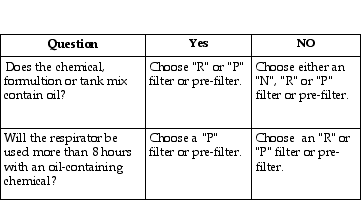
The third question, "Which filter efficiency do I choose?" requires a little
discussion. For all practical purposes, there are two choices, the type 95 and
the type 100. Most manufacturers probably will not make both the type 99 and
100, but only the 100 or HE filter or pre-filter. As a general rule, types 95
and 100 are both good for most pesticide uses. When the job requires a HEPA or
type 100 respirator, the selection should then be the "HE" or type 100.
Nine choices based on filter class and efficiency
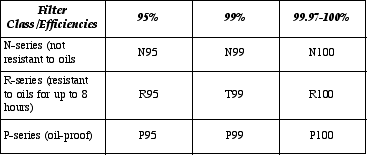
Example uses of new respirator designations
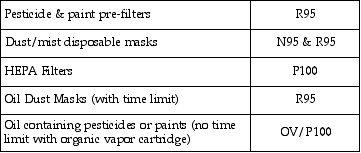
 Would you like to try a study question?
Would you like to try a study question?
 Would you like to try a study question?
Would you like to try a study question?
Powered air-purifying respirators (PAPRs) force air through air-purifying
material (cartridge or canister) to assist the wearer in obtaining clean
filtered air. These are positive pressure respirators and are good for users
with respiratory problems or with facial hair that may prevent a tight seal with
full or half-face respirators. Powered air-purifying respirators purify
contaminated air and do not provide oxygen or supply air from an outside source.
The filters may need to be replaced two or more times each day. The filters and
prefilters should be replaced when:
- The filter element is damaged or torn.
- When the respirator manufacturer or the pesticide label requires it. If their
recommendations are different, use the most frequent interval recommended.
- The end of each day's work period, if no other instructions are available.
Air-Supplying Respirators
Air-supplying respirators are used in situations where the other types of
respirators will not provide enough protection. They are also used when the
oxygen supply is low and when the pesticide label requires one. Supplied-air
respirators supply clean air through a hose directly to the face mask. The
working distance is thus limited to the length of the hose. Wear supplied-air
respirators with a NIOSH/MSHA approval number prefix TC-19C. A self-contained
breathing apparatus (SCBA) supplies clean air from cylinders that are carried.
They allow more freedom of movement and require specialized training for their
proper use. The air supply is limited to between 30 and 60 minutes. Wear SCBA
with a NIOSH/MSHA approval number prefix TC-13F.
 Would you like to try a study question?
Would you like to try a study question?
Use the Respirators Correctly
- The respirator should fit properly on your face. It should be worn tightly
enough to form a seal all around your face. Respirators come in different sizes.
Each person who will wear a respirator must be fit tested prior to using it.
Facial hair must be groomed such that a proper seal between the face and the
respirator is made. This usually means that beards or long sideburns must be
removed. Do not wear the headband too tightly or headaches and/or dizziness may
result.
 Would you like to try a study question?
Would you like to try a study question?
- Respirator manufacturers make a variety of cartridges to fit their face pieces
and each cartridge has its own intended use. It is essential that a cartridge
designed to filter out pesticides from the air be selected and used. Having the
wrong cartridge may expose the applicator to toxic levels of pesticides. Check
the filter (the cloth-like outer layer) of your respirator often. Replace it
when it looks dirty or if breathing becomes difficult. Cartridges should be
changed after every eight hours of use. If you notice a pesticide odor first
check to be sure the respirator is sealed on your face. If the odor persists,
change the cartridge immediately.
 Would you like to try a study question?
Would you like to try a study question?
 Would you like to try a study question?
Would you like to try a study question?
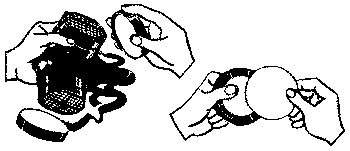
- After each use, wash the face piece with detergent and warm water. Rinse
thoroughly and wipe dry with a clean cloth. Store the respirator,
filters, and cartridges in a clean, dry place away from pesticides. A tightly
closed plastic bag works well for storage.
 Would you like to try a study question?
Would you like to try a study question?
Reducing Risks Through Engineering
Protecting sprayer operators against pesticide exposure involves more than
protective clothing. There are several mechanical devices called "engineering
controls" that can help reduce the risks associated with applying pesticides.
Application tasks with exposure risks
- Adding pesticide concentrate to the tank.
- Rinsing empty containers.
- Folding/unfolding the boom.
- Making repairs and adjustments.
- Changing nozzles.
- Drift from spray boom.
Engineering controls for risk reduction
- Chemical induction system. Allows operator to fill sprayer from the
ground rather than climbing up onto sprayer.
- Closed transfer system. Reduces operator exposure to concentrated
pesticides during filling operation.
- Refillable concentrate containers. Usually made to work with a closed
transfer system; removes the need to rinse used containers.
- Pesticide injection system. Spray tank holds only clean water, no tank
rinsing needed, and spray lines can be flushed clean in the field. Reduces or
eliminates operator exposure if used with refillable container or closed
transfer systems.
- Tank rinsing system. Flushes spray residues from tank, hoses and nozzles,
reducing exposure risk to the operator.
- Hydraulic boom folding. Avoids hand contact with pesticides that may
occur while folding booms manually.
- Diaphragm check valves. Prevents drips from nozzles, which may expose
operator during nozzle repair/changes, or while folding/unfolding manual booms.
- Multi-tip nozzle bodies. Simplifies changing nozzle tips when switching
crops, pesticides or rates.
- Low-drift, twin fluid and air-assisted nozzles. Minimize spray drift and
operator exposure.
- Carbon filters for cab. Improved spray particle filtering for supplying
cleaner air to operator's cab.
- Clean water supply. Used for hand and contaminated PPE washing.
- Protective clothing locker. Keeps clean PPE clean, reduces risk of cross
contamination.
Use Common Sense
Always work in pairs when handling highly toxic chemicals. Watch your co-worker
carefully for unusual behavior or actions. Remind them (and yourself) to wash
their face and hands before eating, drinking, or smoking. Never use the toilet
before washing your hands. It is important to avoid getting toxic pesticides on
any area of your body! At the end of the day remove your contaminated
clothing carefully and put it in a plastic bag, well away from the family
laundry or immediately wash the clothes yourself. Shower and clean yourself
thoroughly from head to toe. Pay particular attention to fingernails and hair
where pesticides could remain.
 Would you like to try a study question?
Would you like to try a study question?
 Would you like to try a study question?
Would you like to try a study question?
Cholinesterase Tests
Consider getting your blood tested to determine your normal or base level of a
natural chemical called cholinesterase. This chemical is necessary for your
nervous system to properly function and without it you will die. Both carbamate
and organophosphate pesticides attack this chemical in your blood and make it
useless. Once your base level of cholinesterase has been determined, a simple
blood test will show if you still have the normal amount. If you do not, you
have been overexposed to either an organophosphate or carbamate pesticide. You
should avoid further contact with these pesticides until your cholinesterase
level has returned to normal. In severe cases antidotes must be given. Follow
your doctor's directions. Any applicator working with highly toxic chemicals
should have his cholinesterase level tested at regular intervals throughout the
spray season. (Cholinesterase tests are not useful for n-methyl carbamate
pesticides.)
 Would you like to try a study question?
Would you like to try a study question?

Entry Restrictions
Entry restrictions are designed to protect people from being exposed to
dangerous levels of pesticides left on treated surfaces. The minimum entry
restriction for all products will be until sprays have dried, dusts have settled
or vapors dispersed. The Worker Protection Standard (WPS) established Restricted
Entry Intervals (REI) for pesticides used to produce agricultural plants. The
REI is a period of time after application of a pesticide during which worker
entry to the treated area is restricted . These REIs are based on the acute
dermal toxicity of the active ingredient, eye irritation effects or skin
irritation effects. For example, all pesticides covered under the WPS in
toxicity category II have REIs of 24 hours.
The product label will state the specific entry restrictions. It will also state
that early reentry (entering a treated area before the entry restriction has
expired) can only be done by personnel wearing specific protective clothing. The
applicator will know that the product is covered by the WPS if the following
statement is in the "Directions for Use" section of the pesticide labeling:
|
"Agricultural Use Requirements
Use this product only in accordance with its labeling and with the Worker
Protection Standard, 40 CRF Part 170. This standard contains requirements for
the protection of agricultural workers on farms, forests, nurseries, and
greenhouses, and handlers of agricultural pesticides. It contains requirements
for training, decontamination, notification, and emergency assistance. It also
contains specific instructions and exceptions pertaining to the statements on
this label about personal protective equipment, notification of workers, and
restricted -entry-intervals."
|
Transport Pesticides Safely
Whenever a pesticide is in your possession, you are responsible for its safe
transport. Do all you can to prevent problems and be prepared in case of an
emergency. Carry pesticides in the back of a truck. Flatbed trucks should have
racks. Steel beds are the best since they can be more easily cleaned if a spill
should occur. Never carry pesticides in the passenger compartment of a vehicle.
Never carry pesticides near passengers, pets, fertilizers, seed, food or feed,
and risk contamination should a spill occur.
All containers should be tightly closed and have legible labels. Secure
containers so they will not roll or slide. Protect all containers from moisture
and temperature extremes. Never leave your vehicle alone when the pesticides are
in an unlocked truck bed or compartment. The legal responsibility for the injury
of curious children or careless adults is yours if the pesticides are left
unattended.
Don't take chances with toxic chemicals. You are gambling with your life as
well as those of others.
Back to Top